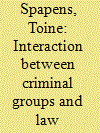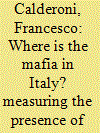| Srl | Item |
| 1 |
ID:
102079


|
|
|
|
|
| Publication |
2011.
|
| Summary/Abstract |
Based on judicial files, data on local criminal associations, and interviews with different categories of privileged witnesses, this article focuses on the city of Gela, in southeastern Sicily, an area apparently immune since the late 1970s to the presence of Mafia organisations. Referring to major literature on organised crime, the first part underlies factors contributing to the creation and establishment of Mafia criminal groups in the city. The second specifically considers the characteristics of local organised crime and its system of infiltrating the social and economic fabric, through violence and intimidation. The last section deals with recent positive signs of opposition to the Mafia by local institutions and civil society, which could also lead to more than merely judicial methods for fighting criminal associations.
|
|
|
|
|
|
|
|
|
|
|
|
|
|
|
|
| 2 |
ID:
102081


|
|
|
|
|
| Publication |
2011.
|
| Summary/Abstract |
The police and the policymakers in the field of organised crime generally assume that criminal groups are very flexible in their responses to law enforcement intervention. They use this flexibility to explain why some forms of organised crime are very difficult to curb. Criminal groups may also develop more effective protection methods over time. Another explanation may be that others are quick to replace apprehended members of criminal groups, or even an entire criminal group that has been dismantled by law enforcement officials. This article addresses these questions empirically by examining the behaviour of criminal groups producing and trafficking ecstasy in the Netherlands between 1997 and 2006. It concludes that such groups were able to adapt to the methods and tactics used by the Dutch police to some extent. The main explanation for the continued production of ecstasy, however, is that criminal groups are replaced by new ones.
|
|
|
|
|
|
|
|
|
|
|
|
|
|
|
|
| 3 |
ID:
102084


|
|
|
|
|
| Publication |
2011.
|
| Summary/Abstract |
A well-known finding of research on illegal markets is that drug-dealing organisations operate in risky and uncertain market and intra-organisational conditions that considerably limit their size and their survival time. Yet, little is known about the organisations or individual dealers who are more successful than others at avoiding arrest and incarceration, especially in regard to dealers operating in groups of various sizes. This article proposes to fill this gap in the literature by fitting a Cox proportional hazard model to 'time to failure' data in a sample of 112 incarcerated male inmates who were active as drug dealers in the 3 years preceding their incarceration. The results show that organisational size is unrelated to survival. Instead, the size of dealers' core criminal networks emerged as a key factor in increasing survival in the drug trade. Other results indicate that involvement in markets for certain drugs (cocaine) is more risky than others (cannabis) and that hard drug users are arrested faster than others.
|
|
|
|
|
|
|
|
|
|
|
|
|
|
|
|
| 4 |
ID:
102082


|
|
|
|
|
| Publication |
2011.
|
| Summary/Abstract |
This article presents the Mafia Index (MI), an index measuring the presence of mafias at the provincial level. In the abundant literature on Italian mafias, relatively few studies have attempted to measure the presence of mafias across the country. A review of previous attempts points out the limitations and methodological shortcomings of existing measurements. The study provides an operational definition of 'mafia' and selects the most appropriate indicators and variables according to multiple criteria. The MI combines data on mafia-type associations, mafia murders, city councils dissolved for infiltration by organised crime, and assets confiscated from organised crime and covers the period between 1983 and 2009. The MI highlights not only the strong concentration of the mafias in their original territories but also their significant presence in the central and northern provinces. This confirms that mafias should not be regarded as typically Southern Italian phenomena, but rather as a national problem.
|
|
|
|
|
|
|
|
|
|
|
|
|
|
|
|